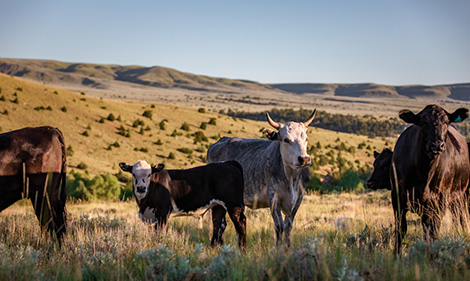Insights on agricultural commodities
AgWest Farm Credit released its Monthly Market Update for January, covering the state of major agricultural commodities in Alaska, Arizona, California, Idaho, Montana, Oregon and Washington. The Update features unique insights into economic drivers impacting agriculture and forestry in the West. In addition to market analysis on 10 major agricultural commodities and crop inputs, the AgWest team has also compiled a Quarterly Economic Update detailing economic drivers, data and trends for Q4 2024.
AgWest’s outlook for major commodities is summarized below. Visit AgWestFC.com/industry-insights to view expanded analysis for each industry, monthly economic headlines, relevant data and trends, and additional special reports.
General sentiment
The agricultural economy is projected to face continued challenges with tight profit margins into 2025. Persistently high production costs and low commodity prices will keep pressuring profitability. With more than half of farmers anticipating worsening financial conditions, risk management will be key in 2025. However, while short-term profitability remains tight, many remain optimistic about the five-year outlook.
Crop inputs
Despite complex market dynamics, crude oil prices have held relatively stable and ended the year where they started. Transportation costs are mixed, with average bulk vessel prices falling in December. Container shipping rates and West Coast trucking rates have increased as shippers frontload cargo in advance of Trump’s inauguration and China’s Lunar New Year, but generally low energy prices are helping to keep transportation rates down. Fertilizer rates are expected to remain stable into 2025, with some potential for disruption from tariffs and escalating conflict in the Middle East.
Almonds and pistachios
The almond industry may be at a turning point, with prices increasing and holding at near break-even levels. This is supported by a smaller than expected 2024 crop and rising demand from overseas. Pistachio prices remain flat, and decreasing year-over-year shipments to retailers are likely the result of a smaller crop as opposed to weak demand.
Apples
The overall sentiment has weakened due to a larger than average 2024 crop and depressed returns. Multiple years of weak markets has impacted succession planning and there are increasing reports of Washington orchards being sold or taken out of production. However, conditions have improved over last year and shipments to retailers are strong. Pear prices are holding strong with a short, good quality crop.
Cattle
Increasing prices and less beef are predicted for the upcoming year. Cattle inventory decreased in 2024, although production was augmented by higher-than-anticipated carcass weights. Import restrictions due to New World Screwworm (NWS) continue to impact the market. 2025 beef production is forecast to decrease 5% over 2024, cattle prices are expected to increase slightly, and beef consumption is expected to decrease.
Dairy
Dairies are optimistic for the upcoming year, with profitable returns expected in 2025. Feed prices are low, and cheese and butter prices have steadied, with milk prices likely to follow. Highly Pathogenic Avian Influenza (HPAI) continues to impact the market with slowed production. The Governor of California declared a state of emergency to provide resources to stop the spread. USDA has mandated bulk testing and has launched financial assistance programs to help offset the cost of testing and milk losses.
Forest products
The industry continues to be impacted by a weak housing market. High interest rates are pressuring home sales and an oversupply of apartments has lowered multi-family construction. Lumber prices generally remain at break-even levels, and log prices are generally flat across the Northwest. A proposed amendment to the Northwest Forest Plan could increase harvest levels on federally managed lands, although it is unknown how likely the amendment is to pass.
Hay
Hay prices are expected to remain low in 2025 with persistently high on-farm inventory levels and low demand. Dairies have been slow to purchase hay with lower-priced feed alternatives available. A strengthening dairy industry may allow for more flexible purchasing, but a smaller national herd will pose additional obstacles. Drought will be a continued concern in 2025 and could impact production, which may serve to enhance prices.
Oranges and lemons
Fresh market orange prices are down, with a smaller-than-average size profile. Juice prices have increased in response to the small crop size, but low returns for growers continue to be a challenge. Lemon prices are also down, although recent rains in the Central Valley are leading to increased fruit sizes. USDA reports an increase in foreign supplier acreage and production for both oranges and lemons in 2025.
Potatoes
Fewer contracted acres and excess supply continue to depress potato prices, with processors reporting weak restaurant purchases and global supply imbalances. Contracted acres are expected to decline further in 2025.
Wheat
Challenges persist into 2025, and grower profitability will hinge on managing production costs, risk management and marketing. Most producers anticipate operating at below or near break-even levels, and forecasted acres are expected to decrease. A decrease in global supply may support increased exports and increased prices. The American Relief Act of 2025, passed by Congress in December, will provide $9.8 billion in relief payments to 20 crops. Relief for wheat producers sits at the top of the list at $31.80/acre.
Wine and wine grapes
Wine sales continue to decrease, but at a slower pace, indicating that the market may be nearing a bottom. Inventory levels remain high and demand low and this will continue to challenge the industry. Anecdotal reports suggest winery visits are decreasing due to reduced discretionary income and alcohol consumption. Harvest season saw good quality fruit, but mixed yields throughout the region.
